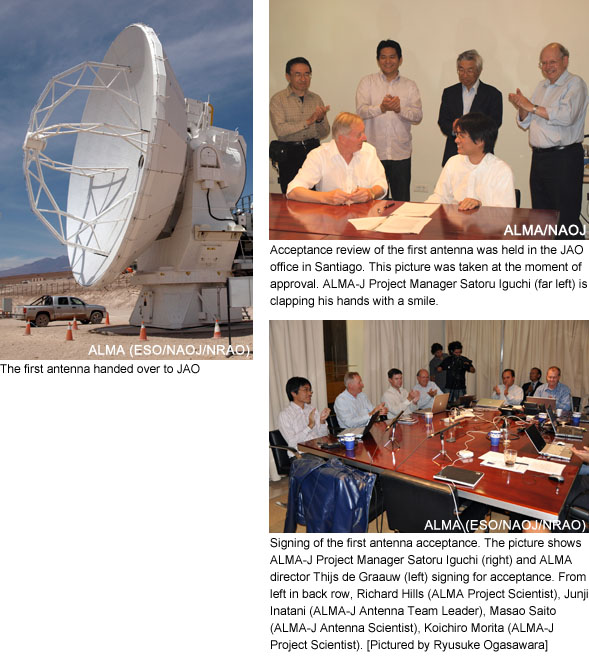Two different types of the receivers Japan developed for ALMA (Atacama Large Millimeter/submillimeter Array) successfully received the first spectrum from the universe. These Japanese receivers, which are designed for the frequency bands Band 4 and Band 8, marked this milestone on June 22 and 30, 2010, respectively. The receivers will undergo detailed performance tests as part of the evaluation process.
-

- June 22, 2010 – Researchers celebrating the reception of the first spectrum by the Band 4 receiver. Shin’Ichiro Asayama, an international staff member of JAO is holding up a picture of the receiver cartridge body, who has been involved in the development of the Band-4 receiver (in the center of the front row). (Picture provided by Rodrigo Romero)
-

- Spectrum of Hydra W (W Hya) received by the Band-4 receiver on June 22
-

- Hydra W (W Hya) (the celestial object in the center)
The source of the radio wave received by the Band-4 receiver is Hydra W (W Hya). This celestial object is well known as strong radio source and often observed to evaluate radio telescope performance. The image (left) shows the radio wave strength of Hydra W with its peak.
There are ten frequency categories of millimeter/submillimeter wavelengths (30 GHz to 950 GHz) — Band 1 through Band 10 — at which ALMA observes celestial objects to ravel the mysteries of the universe. Receivers for each band are developed and fabricated by partner countries of the ALMA Project, and Japan is in charge of the receivers for three bands of them: Band 4 (125 to 163 GHz), Band 8 (385 to 500 GHz), and Band 10(787 to 950 GHz).
For further information on the frequency bands of the ALMA antennas, please visit the ALMA Observatory website .
-

- Japanese Band-4 receiver cartridge
-

- Japanese Band-8 receiver cartridge
The receivers for bands 4 and 8 passed the final design review by the review board consisting of experts held from June 22 through 25, 2009. On September 4, 2009, the Band-4 receiver was shipped out to Chile from the Advanced Technical Center (ATC) of NAOJ in Japan. The receiver was installed onto the antenna at OSF in Chile and has been undergoing evaluation tests. “It is a profound experience that we received the first spectrum with this receiver on June 22, 2010, exactly one year after the final design review,” said Shin’Ichiro Asayama, who was present at the evaluation tests of the Band-4 receiver.
Following the successful reception of the first spectrum with the Band-4 receiver, the Band-8 receiver also received a spectrum from the universe for the first time on June 30, 2010. Japan made a great step forward with this result that two out of three types of receivers Japan develops and fabricates successfully received the first spectrum. These receivers will be tested in more detail for further evaluation.
-

- Spectrum of Sagittarius (SgrB2) received by the Band-8 receiver on June 30
-

- Researchers celebrating the reception of the first spectrum by the Band-8 receiver at OSF
The development and fabrication of the Band-4 and Band-8 receivers are conducted at NAOJ’s own facility ATC in Japan. The fabrication of the second and third receivers for the both bands is in progress toward quantity production while the first receivers do well on the evaluation tests in Chile. “I’m very happy to hear that the delivered receivers are operated without any problems in Chile. We still have a long way to go to complete the production of the entire receivers, but the great news of the first spectrum reception certainly motivates us to keep up the hard work,” said Yutaro Sekimoto, Team Leader of the Band 4 & 8 Cartridge Team who is responsible for cartridge development.
ALMA telescope
Located at the Atacama Desert (5,000 m asl.) in Chile, the gigantic radio telescope ALMA has been constructed in collaboration among East Asia led by Japan, Europe, and North America with the Republic of Chile. NAOJ leads the East Asian component of the effort.
To receive very weak radio waves from celestial objects, the ALMA receivers are required to have the world’s highest performance quality. In an attempt to fulfill the requirement, NAOJ fabricates superconductive SIS mixers, at its own facility ATC, which are installed in the receiver as a key component and convert radio waves from the universe into low frequency signals that can be processed more easily. The fabrication, designing, assembly, adjustment, and testing of other parts for the receiver cartridge are also conducted at ATC.
More information about ALMA:
http://www.almaobservatory.org/









